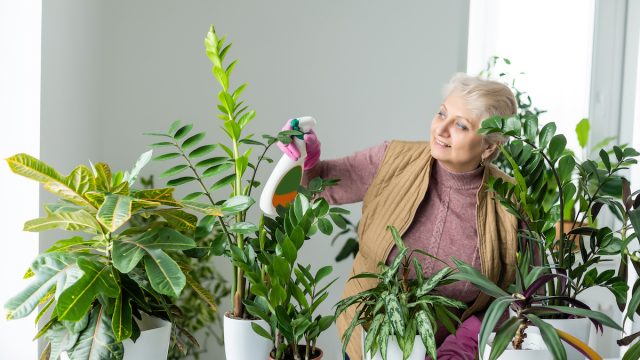These Plants Are the Hardest to Kill, According to Experts
Don't stress over your houseplants with these easy-to-care-for recommendations.
Whether you're a gardening newbie, have a forgetful side (did you water that plant yesterday or two weeks ago?), or travel a lot, it can be difficult to keep your houseplants alive. But don't let a few failed attempts deter you from your green thumb potential. There are plenty of easy-to-care-for plants, and we've rounded up some of the most recommended varieties no matter what your living situation. Read on to hear from experts about the 10 plants that are hardest to kill.
READ THIS NEXT: 5 Easy Hacks to Save Your House Plants That Gardeners Swear By.
1
Snake Plant
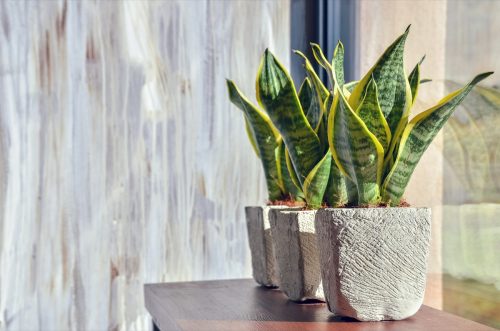
The Snake Plant, or Dracaena trifasciata, is named because its long, slithery leaves resemble the reptile's sharp tongue (this is also why it's facetiously referred to as "Mother-In-Law's Tongue"). Aside from the recognizable moniker, it's also among the most popular houseplants for beginners. Technically a succulent, the Snake Plant is very low-maintenance, explains Erin Marino, editorial director at online houseplant retailer The Sill.
"You can forget to water it and put it almost anywhere in your home," she says. "That said, if you provide it the little it needs to thrive—medium to bright light and water every 2-3 weeks (or when leaves start to wrinkle)—you'll enjoy it for many years to come." She also notes that it was highly ranked on NASA's Clean Air Study, so as a bonus, it'll purify the air in your home.
2
ZZ Plant
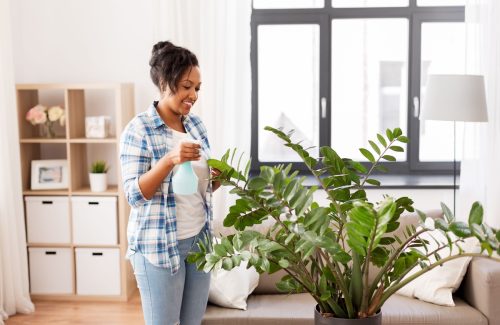
The ZZ Plant is another houseplant that's always at the top of the list for novices. Known for its thick, shiny, and smooth leaves, this houseplant can tolerate very low light, "which makes it great for homes that don't have a lot of windows or are in shade," according to Vladan Nikolic, founder of houseplant care blog Mr. Houseplant.
A succulent native to arid environments, the ZZ Plant, or Zamioculcas zamiifolia, has "evolved rhizomes that store water to help the plant survive drought in its natural habitat," explains Marino. It, therefore, "can go without water for weeks or even months, so it's great for people who travel a lot or are forgetful about watering," says Nikolic. The only real way to kill this plant is by overwatering, and the only concern may be the bigger pot you'll have to purchase because it's growing so much.
3
Pothos

Pothos "can thrive in almost any type of indoor space [because] of its tolerance to less-than-ideal conditions," says Marino, which is why it's earned the nickname "the cubicle plant." Though they prefer medium to bright indirect light, Epipremnum aureum, as they're scientifically known, can tolerate low light and only need to be watered every one to two weeks. If you forget to water them, they're more forgiving than many other plants.
Pothos' vines grow very quickly and can reach more than 10 feet. "When the vines get too long, give them a quick prune and propagate the cuttings in water," suggests Marino. George Tandt, founder of houseplant blog Teak and Terracotta, explains that for this method, "all you need to do is keep the jar topped up [and] try to keep leaves out of the water." Then put the jar in indirect light, and voila!
READ THIS NEXT: The First Things Guests Notice When They Come Into Your Home, Experts Say.
4
Heartleaf Philodendron

How romantic! The Philodendron hederaceum earned its common name thanks to its heart-shaped waxy leaves. Its fast-growing vines also exude that dreamy quality. The Heartleaf Philodendron "can withstand serious abuse," according to Ray Brosnan of Brosnan Landscape Gardening. Just water it every one to two weeks and set it in a spot with medium to bright indirect light (though it can also tolerate low light).
Additionally, "Philos root quite easily so you can turn one singular plant in a jungle fairly quickly with very little effort," he says. And, just like the Pothos, "its long lush vines can be easily pruned and propagated in water when they get too long," shares Marino.
5
Baby Rubber Plant
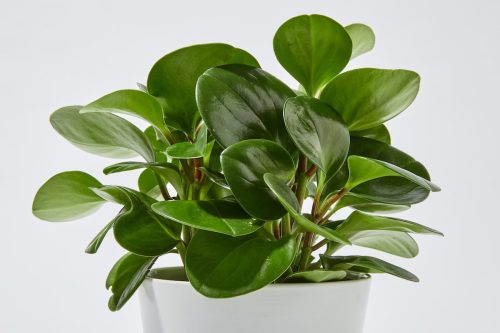
You may recognize the Peperomia obtusifolia, the Baby Rubber Plant, for its thick and glossy leaves. This super popular variety of Peperomia "does not need much to thrive, and under ideal conditions it can flower indoors, producing narrow white spikes," explains Marino. It grows best in bright to medium indirect light, though it will tolerate everything from bright to low light. And it only requires water every one to two weeks. A bonus is that Peperomias are non-toxic and therefore pet-friendly.
There are several other varieties of Peperomia that are also considered good for beginners. If you're looking for a hanging plant, the puteolata (or parallel peperomia) and pereskiifolia "are easy to grow," according to the National Garden Bureau, which declared 2022 the "Year of the Peperomia."
For more plant care advice delivered straight to your inbox,sign up for our daily newsletter.
6
Palms

In general, indoor palms are considered a safe bet for houseplant amateurs (though if you're also a pet parent, be aware that those grass-like leaves are fun to play with!). For a smaller tabletop plant, Marino recommends the Parlor Palm. "It can tolerate a wide range of light conditions but will be happiest in bright indirect light with water every 1-2 weeks. Unlike the palm trees you see on vacation, it is not suited for intense, direct sun." A fun fact she adds is that the Parlor Palm, or Chamaedorea elegans, has been a popular houseplant since the Victorian era!
If you're looking for something larger to go in a floor planter, Marino suggests the Majesty Palm, "a robust, tropical palm with graceful, feathery fronds [that] grow from the trunk in an erect fashion before arching at the ends forming a large crown." Scientifically known as the Ravenea rivularis, this palm can grow up to 10 feet tall and requires similar care to the Parlor Palm, though it can withstand more direct light.
7
Small Succulents
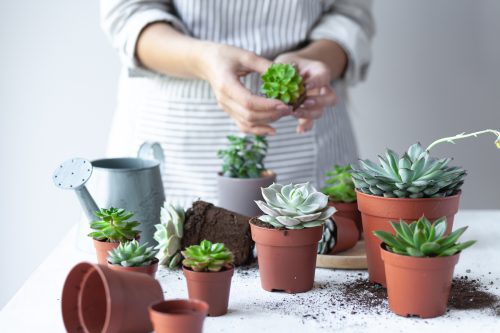
Though several of the larger plants already mentioned are technically succulents—plants that can store water in their leaves or stems—the majority of everyday gardeners think of them as the small, desert-like plants with ultra-thick leaves. Accordingly, most plant shops or online retailers classify them the same way. A perk for those who aren't great at plant care, the smaller varieties tend to require watering even less frequently, sometimes only every two to three weeks.
Kelly Martin, founder of gardening website Urban Garden Gal, is particularly fond of Jade Plants (Crassula ovata), which are called Money Plants for their thick, coin-shaped leaves. "Jade plants prefer to dry out between waterings, so it doesn't matter if you forget to water them for a few days!" Martin also notes that they can go years without having to be repotted.
Sedum morganianum, a trailing succulent known as Donkey's Tail, is a favorite of Jen Stark, founder of Happy DIY Home. She says they are "drought-resistant plants [that] thrive in a well-drained container." They shouldn't be overwatered (once every two weeks is normally fine), and they're perfect for hanging baskets.
READ THIS NEXT: If Your Plants Are Dying, This Simple Trick Will Give Them a Boost.
8
Aloe Vera

The aloe plant is another succulent, but because of the unique benefits of the gel within its leaves, it deserves its own category. The most common household use for aloe vera gel is to treat burns or sunburns, but according to healthline.com, it can aid in everything from heartburn to plaque prevention. It's also a very hearty plant that's hard to ruin. "They only need to be watered once a week, or even less when the temperature is cool," says Martin. "To check if your aloe vera needs watering, stick your finger into the soil to make sure it's dry before watering." Nikolic adds that this is a great plant for frequent travelers and that it can handle everything from low light to full sun.
Another benefit of aloe is that you're likely to end up getting more than one plant out of it. "Aloe vera is also easy to propagate from the 'pups' (baby plants) that grow around the base of the plant," explains Martin. "Just separate them from the mother plant and pot them up."
9
Air Plants
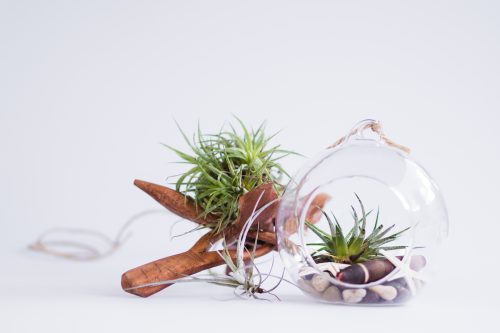
Air plants, or Tillandsias, are so easy to care for that they don't even require soil, making this a nice choice if your children or pets have a tendency to get into the dirt. Brosnan explains that these plants survive in the wild by "attaching to the bark of a tree and catching whatever bits of rain they can in order to stay alive." Therefore, the amount of water they need is minimal, too. "Air plants are able to absorb moisture and nutrients through their leaves, so they only need an occasional misting," says Martin.
As for how to "pot" them, Martin suggests placing them in a bowl, on a bed of pebbles, or in a terrarium. Or, you can hang them in special glass globes that mimic their natural state.
10
Peace Lily
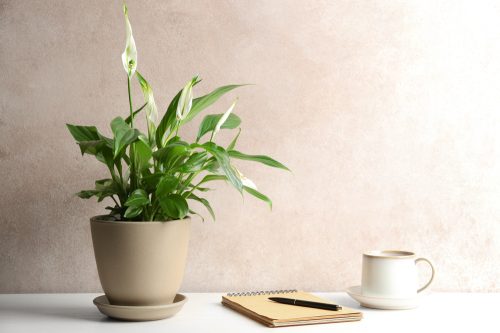
If you're looking for a flowering plant, the Peace Lily is a tough one to kill. "This plant actually likes being under-watered, so you can wait for the top inch or two of soil to dry before watering again," explains Toby Schulz, CEO and co-founder of Lawn.com.au. "Peace lilies can tolerate partial shade but do not do well in cold areas, since they're tropical plants," he adds. This plant is also not susceptible to pests, another perk if you're looking for something low-maintenance.
